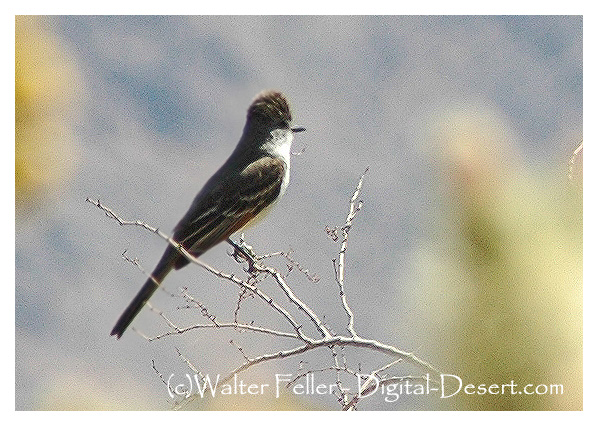Ash-throated Flycatcher
Myiarchus cinerascens
Family: TYRANNIDAE
Order: PASSERIFORMES
Class: AVES
DISTRIBUTION, ABUNDANCE, AND SEASONALITY
A common, summer resident in a wide variety of scrub and woodland habitats below about 1400 m (4500 ft) throughout California, exclusive of the North Coast region. Preferred nesting habitats include chaparral, valley foothill hardwood, valley foothill hardwood-conifer, riparian, desert riparian, Joshua tree, desert wash, pinyon-juniper, and juniper. Widespread spring (April-May) and fall (August) transient, occasionally reaching elevations above breeding range. Winters rarely in southern California (Grinnell and Miller 1944, Garrett and Dunn 1981).
SPECIFIC HABITAT REQUIREMENTS
Feeding: Hawks flying insects from a perch in shrub or tree. Occasionally gleans insects from bark and foliage and eats fruits and seeds (Bent 1942).
Cover: Requires hole or cavity for nesting, low trees or shrubs for foraging perches and other cover.
Reproduction: Nest of hairs, herb stems, feathers, typically placed in tree hole or woodpecker-excavated tree cavity; occasionally in nest box, post, pipe or culvert, or other human-made site.
Water: Frequents dry habitats; does not appear to be an important habitat requirement.
Pattern: Nesters most numerous where trees or snags with cavities are scattered among or border brushland or chaparral, and in willow-cottonwood riparian forest. "Always in the vicinity are bushes, furnishing perches and out-look posts for low-height aerial foraging" (Grinnell and Miller 1944).
SPECIES LIFE HISTORY
Activity Patterns: Yearlong, diurnal activity.
Seasonal Movements/Migration: Arrives in California from Mexico and Central America in March (southern deserts) and April (balance of state), and departs breeding areas by late July and early August. Most southward transients appear in August and September, with stragglers as late as October and November (DeSante and Ainley 1980).
Home Range: No information found, but probably equal to territory. Density estimates range from 0.8 pairs per 40 ha (100 ac) in desert habitat (Emlen 1974), to 23 per 40 ha (100 ac) in Sacramento Valley cottonwood-willow forest (Gaines 1974a).
Territory: In Arizona, Hensley (1954) found a 3 ha (7.3 ac) territory in a desert wash, and a 10 ha (24.7 ac) territory in open desert. In desert riparian habitat along the lower Colorado River in Arizona, mean breeding territory size ranged from 1.38 to 2.55 ha (3.5 to 6.4 ac) in different study areas and years (Laudens layer 1981).
Reproduction: Peak of egg-laying mid-May to mid-June. Monogamous. Incubation about 15 days, probably by female. Clutch usually 4-5 eggs (range 3-7); single-brooded. Altricial young cared for by both sexes. Fledging age 16-17 days (Bent 1942).
Niche: May usurp nest cavities from small woodpeckers.
REFERENCES
Bent, A. C. 1942. Life histories of North American flycatchers, larks, swallows, and their allies. U.S. Natl. Mus. Bull. 179. 555pp.
DeSante, D. F., and D. G. Ainley. 1980. The avifauna of the South Farallon Islands, California. Studies in Avian Biol. No. 4.
Cooper Ornithol. Soc., Lawrence, KA. 104pp.
Emlen, J. T., Jr. 1974. An urban bird community in Tucson, Arizona: derivation, structure, regulation. Condor 76:184-197.
Gaines, D. 1974a. A new look at the nesting riparian avifauna of the Sacramento Valley, California. West. Bird 5:61-80.
Garrett, K., and J. Dunn. 1981. Birds of southern California. Los Angeles Audubon Soc. 408pp.
Grinnell, J., and A. H. Miller. 1944. The distribution of the birds of California. Pac. Coast Avifauna No. 27. 608pp.
Hensley, M. M. 1954. Ecological relations of the breeding bird population of the desert biome in Arizona. Ecol. Monogr. 234:185-207.
Lanyon, W. E. 1961. Specific limits and distribution of ash-throated and Nutting flycatchers. Condor 63:421-449.
Laudenslayer, W. F., Jr. 1981. Habitat utilization by birds of three desert riparian communities. Ph.D. Thesis, Arizona State Univ., Tempe. 148pp.
B326
Life history accounts for species in the California Wildlife Habitat Relationships (CWHR) System were originally published in: Zeiner, D.C., W.F.Laudenslayer, Jr., K.E. Mayer, and M. White, eds. 1988-1990. California's Wildlife. Vol. I-III. California Depart. of Fish and Game, Sacramento, California. Updates are noted in accounts that have been added or edited since original publication.
Written by: D. Gaines
Reviewed by: L. Mewaldt
Edited by: R. Duke
300-birds